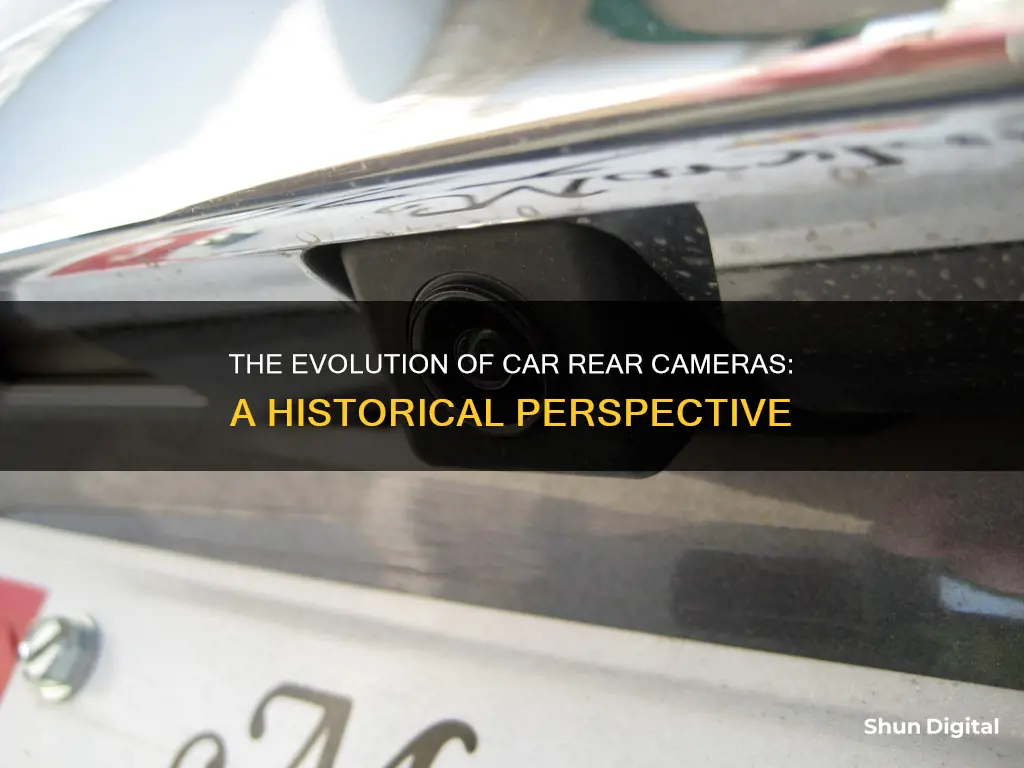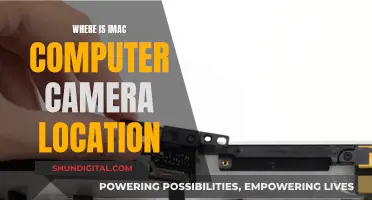
Rearview cameras, also known as backup cameras, have been installed in cars since the 1950s. These cameras are designed to aid drivers in reversing and reducing blind spots. While the technology has been around for decades, it has only recently become standard in newer vehicles. In 2014, the US National Highway Traffic Safety Administration announced that all cars and light trucks manufactured for sale in the US from May 1, 2018, onwards would be required to have backup cameras. This decision was made to improve safety and reduce accidents caused by blind spots. Today, backup cameras are a standard feature in modern vehicles, assisting drivers with parking, blind spots, and other safety measures.
| Characteristics | Values |
|---|---|
| When did rear cameras first appear in cars? | The first car to feature a rear camera was the 1956 Buick Centurion concept car, which was unveiled at the General Motors Motorama in January 1956. |
| When did rear cameras become standard in cars? | All cars and light trucks manufactured for sale in the U.S. since May 1, 2018, have come with backup cameras as standard. |
| Which car was the first to include a rear camera as standard? | The first production car to include a backup camera was the 1991 Toyota Soarer Limited, which was only available in Japan. |
| When did rear cameras become standard in the U.S.? | The first car to include a rear camera in the U.S. was the 2002 Infiniti Q45 sedan. |
What You'll Learn

The 1956 Buick Centurion was the first car with a rear camera
The 1956 Buick Centurion was a concept car that debuted at the 1956 General Motors Motorama Show. It was ahead of its time in many ways, including being the first car to feature a rear camera.
The Centurion was designed with a unique, futuristic aesthetic. Its upper body was red, while its lower body had a brushed metallic finish. The car's "wings", tail cone, and canopy top were influenced by aircraft design, which was popular among GM designers at the time. The Centurion also featured a bubble roof and cockpit, providing unobstructed views all around.
One of the most innovative features of the 1956 Buick Centurion was its rear camera system. Chuck Jordan, an automotive designer in the 1950s, conceived of the idea that a rearview camera could be useful for both backing up and seeing what's behind the vehicle. The Centurion was equipped with a television camera mounted just above the tail cone or in the trunk. This camera transmitted real-time images from the rear of the car to a screen on the dashboard, eliminating the need for a rearview mirror. While the technology was less advanced than today's systems, it was a groundbreaking concept at the time.
The Centurion's rear camera system was bulkier than modern versions, but it was undoubtedly cutting-edge for its era. Interestingly, the idea didn't immediately catch on, even within Buick. It would be decades before rearview cameras became standard in automobiles.
In addition to its rear camera, the Centurion introduced several other new features. It was one of the first cars to have bucket seats, which were common in European cars but not yet standard in the United States. The Centurion also featured headrests, which were not typically found in American cars at the time. Additionally, the car's bubble dome roof inspired the modern-day sunroof and moonroof designs.
The 1956 Buick Centurion concept car was a pioneer in automotive design, and its impact can still be seen in modern vehicles. While some of its features, like the rear camera, took decades to become standard, the Centurion's innovative spirit helped shape the future of the automotive industry.
Strategies for Requesting Community Service for a Camera Ticket
You may want to see also

Rear cameras became standard in US cars in 2018
Rearview cameras, also known as backup cameras, have been a required safety feature in all new cars manufactured and sold in the US since May 1, 2018. This was the result of a federal requirement mandating their inclusion in all new cars and light trucks. The National Highway Traffic Safety Administration (NHTSA) announced this requirement in 2014, giving carmakers until May 1, 2018, to comply. This decision was influenced by safety advocates who recognised the potential for rearview cameras to save lives, particularly in accidents where drivers are backing up and cannot see behind the vehicle.
The history of backup cameras goes back to the 1950s. The 1956 Buick Centurion concept car, unveiled by General Motors in 1956, was the first vehicle to feature a rearview camera. However, the bulkiness of the camera and its limited adoption in subsequent years meant that it would be several decades before backup cameras became standard in vehicles.
The first production car to incorporate a backup camera was the 1991 Toyota Soarer Limited, which was only available in Japan. It took another 11 years for a vehicle with a backup camera to become available in the US market, with the introduction of the 2002 Infiniti Q45 sedan. Over the course of the 2000s and early 2010s, rearview monitors gained popularity, and by the model year 2015, they had become standard equipment on several vehicle brands, including Acura, Buick, Honda, and Infiniti.
The effectiveness of rearview cameras in improving safety has been the subject of studies. While a 2019 study by the Insurance Institute for Highway Safety (IIHS) found that backup cameras alone reduced collision rates by only 5%, combining them with rear parking sensors and automatic rear braking resulted in a 78% reduction in collision rates.
Mastering Focus Pulls with Your Mirrorless Camera
You may want to see also

Rearview monitors became popular in the 2000s and 2010s
The advantages of rearview monitors include the ability to see what is directly behind the car, below the rear window or trunk level, and to eliminate blind spots. Backup cameras also provide a wider field of vision and can help with parking by providing a clearer view of obstacles and warning tones when objects are nearby. Additionally, almost all backup cameras feature on-screen guidelines to assist with parking, and some even change the colour of the guidelines from green to yellow to red as objects become closer.
Nissan, for example, offers an Intelligent Around View Monitor that uses four wide-angle cameras mounted on the front, each side mirror, and the rear of the vehicle to create a virtual 360-degree bird's-eye view. This system also includes Moving Object Detection, providing audio and visual alerts if movement is detected around the vehicle.
In May 2018, a federal law was enacted requiring all new passenger cars, trucks, vans, and other vehicles weighing less than 10,000 pounds to be equipped with rearview monitoring technology, typically in the form of rear-mounted video cameras. This legislation further contributed to the popularity and prevalence of rearview monitors in the late 2010s and beyond.
Hide Your Backdrop with a Virtual Camera Background
You may want to see also

Backup cameras can be aftermarket additions
The backup camera, also known as a rearview or reversing camera, is a standard safety feature in newer vehicles. It is a video camera installed at the rear of a vehicle to aid in reversing and reduce the rear blind spot, which has been described as a "killing zone". Backup cameras became mandatory in all new American-made cars in May 2018, but the technology has been around for decades.
The 1956 Buick Centurion concept car, unveiled by General Motors in 1956, was the first vehicle to feature a backup camera. However, the bulky design did not catch on, and it wasn't until 1991 that the first production car with a backup camera, the Toyota Soarer, was released in Japan. It took another 11 years for a vehicle with backup camera technology to be available in the US, with the 2002 Infiniti Q45 sedan.
Backup cameras became increasingly popular over the course of the 2000s and early 2010s, with consumers appreciating the feature and officials advocating for their inclusion in all vehicles. In 2014, the US National Highway Traffic Safety Administration (NHTSA) announced that all newly manufactured vehicles sold in the US from May 2018 onwards would be required to include backup cameras. This was due to the high number of fatalities and injuries caused by backover accidents, with rearview mirrors alone not providing a wide enough field of vision.
If your car does not have a backup camera, you can add one as an aftermarket addition. Aftermarket backup cameras are available in both wired and wireless versions, with the latter being a smart choice for older vehicles that lack an infotainment screen. The cost of a wireless backup camera with a monitor typically ranges from $100 to $200, while a wired camera integrated into a vehicle's infotainment screen or rearview mirror can cost between $200 to $500.
The simplest option for installation is a wireless camera, as it does not require drilling holes or splicing wires. A wired camera connection involves more labour and may include creating a hole or flush mounting point for the camera, as well as running wires through the vehicle. If you prefer, professional installation is also available at a relatively affordable cost.
Turo Cars: Are Cameras Watching You?
You may want to see also

Wireless backup cameras are available
The history of rearview cameras in cars goes further back than many people realise. The first car to feature a rearview camera was the 1956 Buick Centurion concept car, which was presented in January 1956 at the General Motors Motorama. The vehicle had a rear-mounted television camera that sent images to a TV screen on the dashboard in place of the rear-view mirror. However, the first production car with a rearview camera was the 1991 Toyota Soarer, which was only available in Japan.
In 2014, the U.S. National Highway Traffic Safety Administration (NHTSA) announced that all newly manufactured vehicles sold in the U.S. would need to include backup cameras as a standard safety feature, effective from May 1, 2018. This regulation also applies to Canada.
There are a variety of wireless backup cameras on the market, with features such as HD 1080p resolution, night vision, magnetic scratch-proof installation, and solar-powered charging. Some wireless cameras are designed for specific types of vehicles, such as trucks, SUVs, RVs, and trailers. When choosing a wireless backup camera, it is important to consider factors such as image quality, low-light performance, ease of installation, durability, and screen size and compatibility.
Calibrating Your Lith Battery: A Step-by-Step Guide
You may want to see also
Frequently asked questions
Rearview cameras first appeared in the 1956 Buick Centurion concept car, unveiled by General Motors in 1956.
Since May 1, 2018, all cars and light trucks manufactured for sale in the U.S. have been required by law to include rearview cameras.
Infiniti was the first automaker to offer a rearview camera as standard in the U.S. with the 2002 Q45 sedan.
No, prior to 2018, many cars were equipped with rearview cameras as either standard or optional equipment.
Rearview cameras improve safety by helping the driver avoid collisions while backing up, and they can also assist with blind spots and parking.







